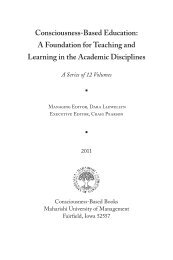The Bhagavad-Gita: A Case Study in Vedic Psychology - Maharishi ...
The Bhagavad-Gita: A Case Study in Vedic Psychology - Maharishi ...
The Bhagavad-Gita: A Case Study in Vedic Psychology - Maharishi ...
Create successful ePaper yourself
Turn your PDF publications into a flip-book with our unique Google optimized e-Paper software.
MODERN SCIENCE AND VEDIC SCIENCE<br />
As <strong>Maharishi</strong> (1986a) expla<strong>in</strong>s, the <strong>Vedic</strong> literature, <strong>in</strong> which the <strong>Vedic</strong> case studies<br />
are expressed, has its source <strong>in</strong> the self-<strong>in</strong>teract<strong>in</strong>g dynamics of the field of pure<br />
consciousness (please refer to Dillbeck, 1988). <strong>The</strong> <strong>Vedic</strong> literature is the literature of<br />
consciousness and natural law, express<strong>in</strong>g all the qualities of consciousness and all the<br />
dynamics of natural law (<strong>Maharishi</strong> Mahesh Yogi, 1986a). <strong>The</strong> <strong>Vedic</strong> case studies have<br />
been articulated by <strong>in</strong>dividuals who directly cognized these dynamics of natural law <strong>in</strong><br />
the highest level of consciousness, and the case studies are therefore evolutionary,<br />
<strong>in</strong>spir<strong>in</strong>g, and life-support<strong>in</strong>g for everyone, no matter what the <strong>in</strong>dividual's level of consciousness.<br />
<strong>Maharishi</strong> (1982) has noted that the <strong>Vedic</strong> records have a mean<strong>in</strong>g at every<br />
level of evolution of the <strong>in</strong>dividual. <strong>The</strong> same account will therefore be comprehended<br />
on <strong>in</strong>creas<strong>in</strong>gly profound levels as one grows <strong>in</strong> consciousness, until one comprehends<br />
its significance on the level from which it was orig<strong>in</strong>ally expressed, unity consciousness.<br />
Thus, the <strong>Vedic</strong> case studies provide guides to life throughout the entire range of<br />
seven states of consciousness outl<strong>in</strong>ed by <strong>Maharishi</strong> <strong>Vedic</strong> <strong>Psychology</strong> (please refer<br />
to Alexander & Boyer, 1989), but are most mean<strong>in</strong>gful as one's consciousness develops<br />
to higher states.<br />
For this reason the greatest benefit from the <strong>Vedic</strong> case studies is ga<strong>in</strong>ed when the<br />
<strong>in</strong>dividual is develop<strong>in</strong>g higher states of consciousness through the <strong>Maharishi</strong><br />
Transcendental Meditation and TM-Sidhi programs. <strong>The</strong>n the <strong>in</strong>dividual spontaneously<br />
relates the content of the <strong>Vedic</strong> case studies to his or her own experience of development<br />
of consciousness; the understand<strong>in</strong>g and memory of the <strong>Vedic</strong> case studies broadens<br />
<strong>in</strong>tellectual appreciation of one's own experiences, raises self-confidence, and thus supports<br />
the natural direction of one's own development (<strong>Maharishi</strong> Mahesh Yogi, 1982).<br />
In addition, <strong>Maharishi</strong> (1982) has expla<strong>in</strong>ed that the <strong>Vedic</strong> case studies profoundly<br />
<strong>in</strong>fluence the <strong>in</strong>dividual through their sound. As was discussed <strong>in</strong> a previous article <strong>in</strong><br />
this series on the experience of the Ved (Dillbeck, 1989), the organiz<strong>in</strong>g power of a<br />
word exists on two levels: the mean<strong>in</strong>g and, more importantly, the direct <strong>in</strong>fluence of<br />
the sound vibrations on the physical structure of the nervous system. Because the <strong>Vedic</strong><br />
literature is expressed <strong>in</strong> the "language of nature itself"—the sounds expressed by the<br />
self-<strong>in</strong>teract<strong>in</strong>g dynamics of the field of pure consciousness—its sound quality directly<br />
produces a life-support<strong>in</strong>g <strong>in</strong>fluence on one's physiological function<strong>in</strong>g. <strong>The</strong> sound of<br />
the <strong>Vedic</strong> stories is said by <strong>Maharishi</strong> (1982) to generate an <strong>in</strong>fluence that purifies the<br />
area of physiological function<strong>in</strong>g associated with the weakness or problem addressed<br />
by the work. In this way, the <strong>Vedic</strong> case studies directly support the purification of<br />
physiological function<strong>in</strong>g that takes place through the Transcendental Meditation and<br />
TM-Sidhi programs (Wallace, 1986). <strong>The</strong> goal of this physiological purification is the<br />
permanent establishment of the experience of pure consciousness as the basis for all<br />
th<strong>in</strong>k<strong>in</strong>g and activity; this cont<strong>in</strong>uum of pure awareness forms an unshakable foundation<br />
of <strong>in</strong>ner satisfaction <strong>in</strong> higher states of consciousness, which no chang<strong>in</strong>g situation<br />
can overshadow.<br />
Examples of case studies may be found <strong>in</strong> the Upanishads and the Puranas, as well as<br />
other parts of the <strong>Vedic</strong> literature. <strong>The</strong> Brahman aspect of the Ved, of which the<br />
Upanishads are one part, expresses the <strong>in</strong>f<strong>in</strong>ite organiz<strong>in</strong>g power <strong>in</strong>herent <strong>in</strong> the structure<br />
of pure knowledge—the Ved. (Please refer to Dillbeck, 1989.) <strong>Maharishi</strong> (1987)<br />
100

















